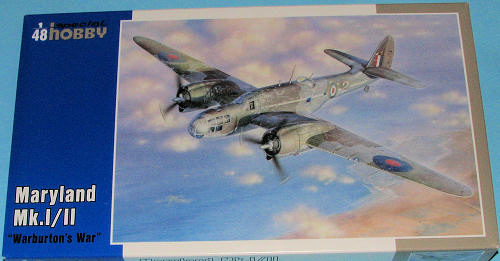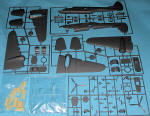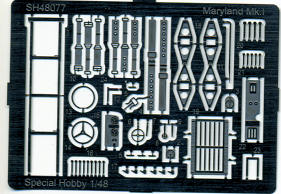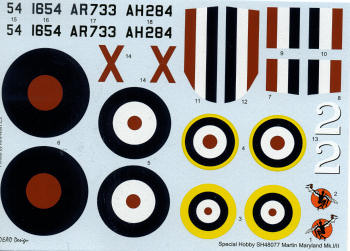
Special Hobby 1/48 Maryland I/II
| KIT #: | SH 48077 |
| PRICE: | ¥7,650 at Hobby Link Japan |
| DECALS: | Four options |
| REVIEWER: | Scott Van Aken |
| NOTES: | Limited run kit with resin and photo etch parts |

| HISTORY |
In response to a US Army Air Corps light bomber requirement issued in 1938, the Glenn L. Martin Company produced their
Model 167 which was given the official designation XA-22. Martin's design was a twin-engine fully-metallic monoplane, capable of around 310 mph (447 km/h) and carrying a crew of three. The bombardier sat in the nose below the cockpit, and self-defense was provided by a mid-upper twin-machine gun turret, as well as four forward firing light machine guns in the wings.The XA-22 was not adopted for operational service in the US as the contract was won by Douglas with its A-20. But Martin received foreign orders, and eventually about 450 of these relatively fast, twin engined planes were built.
Facing German arms buildup and desperate for modern aircraft, the French Air Force purchased US aircraft of numerous types in the late 1930s. Martin received an order for more than 200
167 Fs which incorporated French-specific equipment such as metric instruments. French officials expected the deliveries to begin in January 1939 but the type, locally designated Glenn Martin 167 A-3 only entered service in early 1940. Notably, because of the U.S. embargo on arms exports after the beginning of World War II, many planes were impounded for two months before being shipped to Europe. When the Germans eventually invaded France there were only four Groupes de bombardement(bomber squadrons) equipped. The Glenns were quickly sent to the frontlines where they performed honorably with their sufficient speed and excellent maneuverability for an airplane in this class, they sometimes had a chance to avoid enemy fighters. In more about 350 sorties versus the Germans, they suffered a loss rate of only 4%, much better than the 16% endured by LeO 451s and their crews above the same targets.Immediately before the June 1940 Armistice, units flying the Glenn Martin 167 were evacuated to French North Africa to avoid capture by the Germans. One of them landed in Spain and was interned, being tested by the Spanish Air Force. Some examples were transferred to the Aéronautique Navale. During the Vichy rule on the French empire, French Martins occasionally clashed with British Commonwealth forces, most notably during the Syria-Lebanon campaign of 1941. As French North Africa got back in the Allied camp in 1943, M.167s were phased out of service and replaced with more modern Allied types, including the Martin B-26 Marauder.
Approximately 215 Martin 167s were delivered to France.
After the Franco-German Armistice, all remaining planes on the French order were shipped to the United Kingdom where they received the designation
Maryland Mk.I. Many of the planes were eventually shipped to Egypt and Malta in time for the 1941 fighting there. In the British Fleet Air Arm, at any rate, they seem to have seen little combat, being used for spotting and target towing duties. The RAF used the aircraft to some effect for photo-reconnaissance operations in North Africa. A Maryland bomber was the aircraft sent to gather photographs of the Italian Fleet before and after the battle of Taranto on 11 November 1940. The pilot of that Maryland was the famous ace Adrian Warburton, who scored his five confirmed kills with the Maryland's forward-firing guns - the only person ever to achieve ace status in a bomber type. The Maryland also brought back the pictures that alerted the British that the German battleship Bismarck had left harbor on 22 May 1941.| THE KIT |
 Molded
in their usual grey plastic with very nicely done engraved panel lines, there
are four major sprues plus one in clear plastic and a bag of resin. The resin is
mainl
Molded
in their usual grey plastic with very nicely done engraved panel lines, there
are four major sprues plus one in clear plastic and a bag of resin. The resin is
mainl y
engines with the twin row Pratt & Whitney's having individual cylinders to place
on a resin engine block. That is a total of 28 cylinders for the two engines.
Personally, I'd like to have seen just a one or two piece engine, but it does
add to the parts count. A nice photo-etch fret is also included that has things
like some interior updates (where you have to cut away some of the plastic
parts), as well as belts, switches, console faces and such. There are also a few
external parts like oleo scissors on the fret as well.
y
engines with the twin row Pratt & Whitney's having individual cylinders to place
on a resin engine block. That is a total of 28 cylinders for the two engines.
Personally, I'd like to have seen just a one or two piece engine, but it does
add to the parts count. A nice photo-etch fret is also included that has things
like some interior updates (where you have to cut away some of the plastic
parts), as well as belts, switches, console faces and such. There are also a few
external parts like oleo scissors on the fret as well.
The rest of the kit is pretty much what you'd expect
from MPM/Special Hobby. The cockpit section is well detailed with a combination
of plastic, resin and photo etched bits to add detail. As mentioned, some of
these bits will need to cut to accommodate the photo etch or to do the correct
variant, but nothing major. Equally well detailed is the mid section where the
gunner and radio operator reside. I'm not sure how much of this will be visible
once the kit is done, though. The rest of the air frame is pretty straight
forward. No major bits an d
pieces in terms of options are supplied. The engine cowlings are several pieces
and may well be one of the more fussy parts of the build. The clear nose section
is two parts and should provide no problems. The clear parts are well molded and
clear enough to show detail inside.
d
pieces in terms of options are supplied. The engine cowlings are several pieces
and may well be one of the more fussy parts of the build. The clear nose section
is two parts and should provide no problems. The clear parts are well molded and
clear enough to show detail inside.
Instructions are well done and provide Gunze paint references. Markings are provided for four aircraft, two of them are flown by bomber ace Adrian Warburton. One is the box art plane in French camo with British insignia added over the French markings. The other is a very standard looking aircraft in the temperate scheme of Brown/Green over Sky. For the French camo plane, the modeler will have to paint the white stripe on the fuselage as it is not supplied on the decal sheet. A third option is a desert scheme plane from 39 Squadron. The fourth option is also in the desert camouflage with 24 Sq SAAF. I think Special Hobby missed something on this one, though I'm not positive. Most SAAF planes had orange replacing the red in the insignia. This is not provided on the decal sheet. The decals are very nicely printed and should work as well as any quality aftermarket set.
| CONCLUSIONS |
All in all, this looks like a superb kit, especially as the Maryland is a very sleek looking bomber. It will add a lot to your 1/48 twins collection.
| REFERENCES |
http://en.wikipedia.org/wiki/Martin_Maryland
June 2010
Thanks to Hobby Link Japan for the review kit. You can get yours at http://www.hlj.com/product/SPH48077
If you would like your product reviewed fairly and quickly, please contact me or see other details in the Note to Contributors.